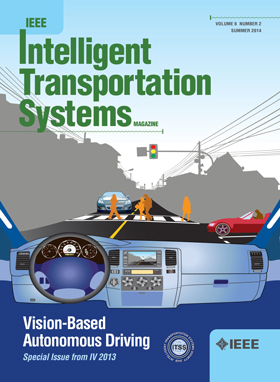Semantically Adversarial Scene Generation With Explicit Knowledge Guidance
IF 7.9
1区 工程技术
Q1 ENGINEERING, CIVIL
IEEE Transactions on Intelligent Transportation Systems
Pub Date : 2025-01-06
DOI:10.1109/TITS.2024.3510515
引用次数: 0
Abstract
Generating adversarial scenes that potentially fail autonomous driving systems provides an effective way to improve their robustness. Extending purely data-driven generative models, recent specialized models satisfy additional controllable requirements such as embedding a traffic sign in a driving scene by manipulating patterns implicitly at the neuron level. In this paper, we introduce a method to incorporate domain knowledge explicitly in the generation process to achieve Semantically Adversarial Generation (SAG). To be consistent with the composition of driving scenes, we first categorize the knowledge into two types, the property of objects and the relationship among objects. We then propose a tree-structured variational auto-encoder (T-VAE) to learn hierarchical scene representation. By imposing semantic rules on the properties of nodes and edges into the tree structure, explicit knowledge integration enables controllable generation. To demonstrate the advantage of structural representation, we construct a synthetic example to illustrate the controllability and explainability of our method in a succinct setting. We further extend to realistic environments for autonomous vehicles, showing that our method efficiently identifies adversarial driving scenes against different state-of-the-art 3D point cloud segmentation models and satisfies the constraints specified as explicit knowledge.生成可能使自动驾驶系统失效的敌对场景,是提高其鲁棒性的有效方法。在纯数据驱动生成模型的基础上,最近的专门模型满足了额外的可控要求,例如通过在神经元级别隐式操作模式,将交通标志嵌入驾驶场景中。在本文中,我们介绍了一种将领域知识明确纳入生成过程的方法,以实现语义对抗生成(SAG)。为了与驾驶场景的构成保持一致,我们首先将知识分为两类,即物体的属性和物体之间的关系。然后,我们提出了树状结构变异自动编码器(T-VAE)来学习分层场景表示。通过将节点和边缘属性的语义规则强加到树状结构中,显式知识集成实现了可控生成。为了证明结构表示法的优势,我们构建了一个合成示例,以说明我们的方法在简洁环境中的可控性和可解释性。我们还进一步扩展到自动驾驶汽车的现实环境中,表明我们的方法能在不同的最先进三维点云分割模型中有效识别对抗性驾驶场景,并满足作为显性知识指定的约束条件。
本文章由计算机程序翻译,如有差异,请以英文原文为准。
求助全文
约1分钟内获得全文
求助全文
来源期刊

IEEE Transactions on Intelligent Transportation Systems
工程技术-工程:电子与电气
CiteScore
14.80
自引率
12.90%
发文量
1872
审稿时长
7.5 months
期刊介绍:
The theoretical, experimental and operational aspects of electrical and electronics engineering and information technologies as applied to Intelligent Transportation Systems (ITS). Intelligent Transportation Systems are defined as those systems utilizing synergistic technologies and systems engineering concepts to develop and improve transportation systems of all kinds. The scope of this interdisciplinary activity includes the promotion, consolidation and coordination of ITS technical activities among IEEE entities, and providing a focus for cooperative activities, both internally and externally.
 求助内容:
求助内容: 应助结果提醒方式:
应助结果提醒方式:


